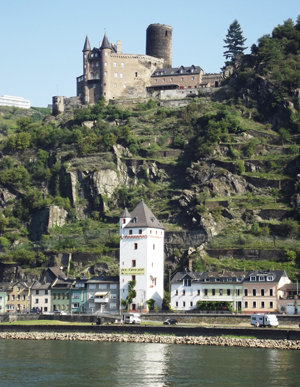PRAGUE – The landscape is lush. Inviting. A panoply of sizes, shapes and colours neatly stitched together in a seamless portrait reminiscent of early Flemish paintings
Each scene is dramatic, breathtaking and somewhat different than the last. It’s a bit like walking through a renowned museum where each room offers some unique and unforgettable creativity. But instead of walking, I’m on a moving sidewalk, one that glides past each scene languidly as I marvel at this feast for the senses.
Uniworld’s River Ambassador ship is my portal to this outdoor museum and my sidewalk is Germany’s legendary Rhine River.
On both sides of the river, high on steep cliffs and mountainsides, imposing castles and fortresses offer a glimpse into medieval history when wealth and power resided in individuals and families and not the state. Most of these stone structures are empty now, but some still serve as museums or tourist attractions, as well as offering opportunities for that once-in-a-lifetime vacation photo.
River cruising provides such sights and memories on a daily basis. The cruise down the Rhine toward Cologne was the finale of a 10-day journey that began with a brief stay in the Czech capital of Prague.
Boarding for the cruise began in Nuremberg on the Main River and would continue to the city of Aschaffenburg where the Main intersects with the Rhine.
Along the way, in cities that aren’t household names but are still intriguing and delightful, passengers are exposed to a portion of Germany’s Romantic Road, royal gardens, an eclectic mixture of Gothic, Renaissance and Baroque architecture and castles — lots of castles.
The cruises offer intimate encounters with towns and cities that big ships can’t match. Ships dock near the centre of each destination and a leisurely stroll or a short bus ride puts you in the middle of the action within minutes. That’s probably why river cruises have more than tripled in popularity in the last 10 years.

Above: River cruising is one of the most relaxed modes of transportation.
Touring isn’t the only attraction of river ships. Other, mostly complimentary, activities include wine tastings, culinary demonstrations (sausage-making was a part of our German itinerary), seminars on local activities such as glass-making, plus entertainment by folkloric groups.
But mostly, the destinations are the lure. Prague is often referred to the “The Paris of Eastern Europe,” and Paris should be flattered. Churches and palaces are virtually on every corner and it is an idyllic walking city. Highlights are the National Museum, state opera house, Wenceslas Square and, of course, Prague Castle, the former home of kings, emperors and presidents for nearly a thousand years.
Tourists flock to Prague’s Charles Bridge, built by King Charles IV centuries ago. The bridge spans the Vltava River and is pedestrian only. Among its most charming characteristics are the vendors who sell inexpensive crafts and paintings of every description.
Tourists flock to Prague’s Charles Bridge, built by King Charles IV centuries ago. The bridge spans the Vltava River and is pedestrian only. Among its most charming characteristics are the vendors who sell inexpensive crafts and paintings of every description.
Not far from the bridge is Old Town, or Stare Mesto. Here in the square is the remarkable Astronomical Clock on the city hall building. Every hour, the square is jammed with people waiting to see the figures of the Apostle emerge as the clock strikes.
But Prague and its abundant treasures is just the beginning: the riches of Germany beckon. German cities on the itinerary include Nuremberg, Bamberg, Wurzburg, Miltenberg, Aschaffenburg, Koblenz and Cologne.
All have sights too numerous to mention. In Nuremburg, it’s the fascinating history of the Nazi party and their huge rallies here; Bamberg once served as the capital of the Holy Roman Empire; Wurzburg was almost obliterated by Allied bombing in World War II, but has since been restored to its ancient splendour.
 Left: River cruises pass great castles and icons of the past.
Left: River cruises pass great castles and icons of the past.
Miltenberg is another of those sleepy medieval towns hardly ever mentioned in guide books. Nestled below wooded hills on a bend of the Main River, it is one of the most photogenic cities on the trip, but its greatest claim to fame is that it was a favourite stop for Frederick Barbarossa, the charismatic Holy Roman Emperor and Crusader. Aschaffenburg boasts the mighty SchlossJohannisburg, which numbered Napoleon Bonaparte and Austrian Empress Maria Theresa among its guests. The castle houses a museum with notable art collections.
Lastly, Koblenz, at the confluence of the Rhine and Moselle rivers, is a cultural, administrative and business centre, and features the massive 12th-century fortress, Festung Ehrenbreitstein, reputed to be the largest in Europe.
Sadly, this is the last stop on a marvelous journey before disembarking in Cologne, but is shouldn’t be your last river cruise — there are far too many more destinations to discover.
About the Author
Tom Wuckovich lives in Tampa and is the former senior editor at AAA Going Places Magazine. He currently works as a part-time writer and editor for the Tampa Tribune. He is a long-time member of the Society of American Travel Writers.